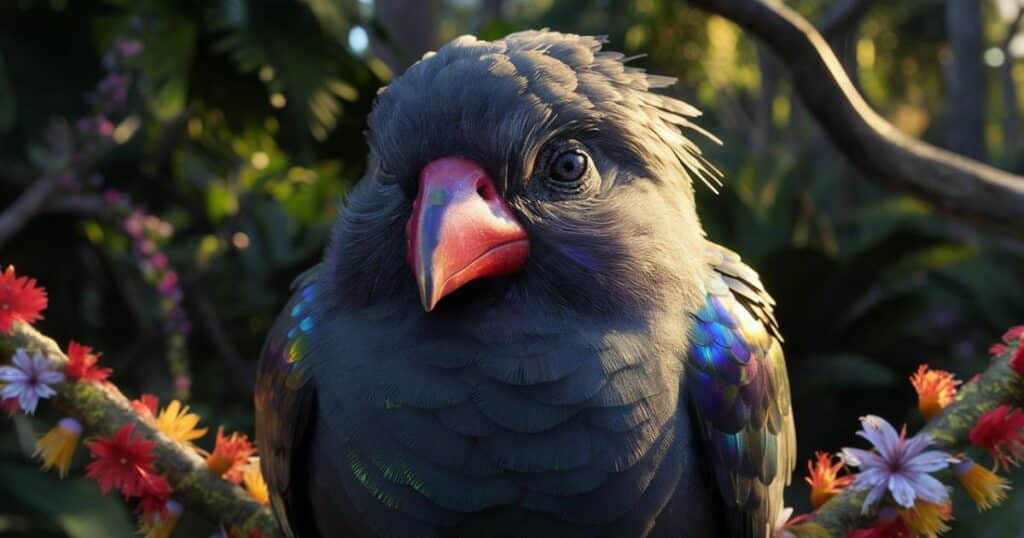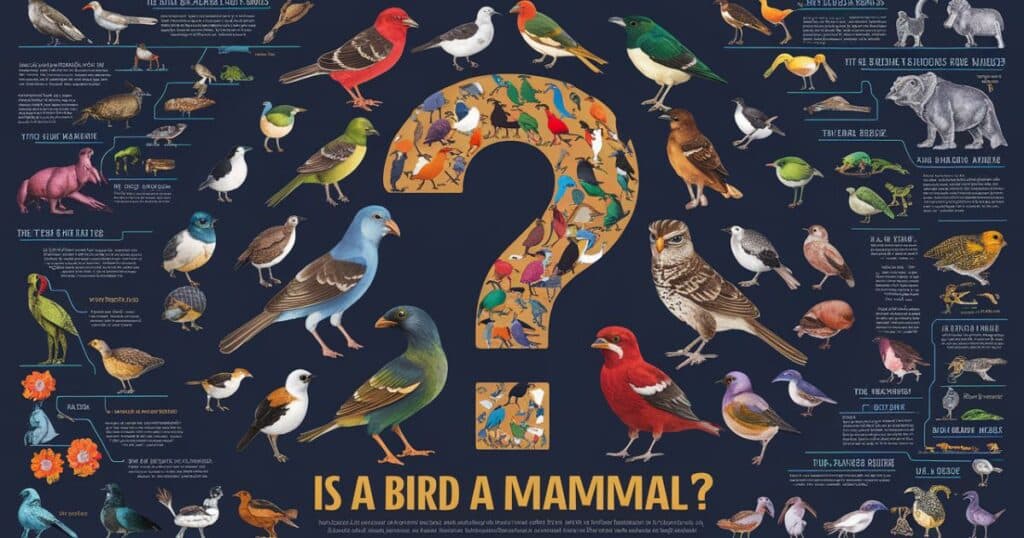Have you ever wondered if birds are classified as mammals? While it may seem like a simple question, understanding the avian classification and how it differs from mammals is crucial for anyone interested in birding, bird identification, or birdwatching.
In this comprehensive guide, we’ll dive deep into the world of birds, mammals, and their unique characteristics, shedding light on the distinct differences between these two fascinating groups of animals.
Understanding Bird Classification
What are avians?

Avians, also known as aves, are a diverse group of warm-blooded vertebrate animals characterized by their feathers, toothless beaked jaws, laying of hard-shelled eggs, and four-chambered hearts. This class includes an estimated 10,000 living species of birds, ranging from the tiny bee hummingbird found in Cuba to the towering ostrich, the largest living bird.
Examples of other avians
While most people are familiar with common bird species like sparrows, robins, and pigeons, the avian class encompasses a wide range of fascinating creatures. Some notable examples include:
- Penguins
- Ostriches
- Eagles
- Hummingbirds
- Flamingos
- Parrots
Are Birds Animals?
What is the Animal Kingdom?
The Animal Kingdom, also known as Animalia, is one of the five kingdoms of life, which includes various multicellular organisms that share common characteristics, such as being heterotrophic (consuming organic material for sustenance), lacking cell walls, and exhibiting some form of mobility during at least part of their life cycle.
How Do We Know That Birds Are Animals?
Birds undoubtedly belong to the Animal Kingdom as they possess all the essential characteristics that define animals. Like other animals, birds:
- Are multicellular organisms
- Lack cell walls
- Are heterotrophic (consuming organic material for food)
- Exhibit mobility and movement
- Reproduce sexually
By meeting these criteria, birds firmly establish themselves as members of the Animal Kingdom.
What are Mammals?
Mammals are a distinct class of vertebrate animals characterized by several unique traits that set them apart from other animal groups.
Characteristics of Mammals
Hair or Fur
One of the most distinctive features of mammals is the presence of hair or fur, which serves various purposes, including insulation, protection, and sensory functions.
Mammary Glands
Mammals are named after their defining characteristic: the presence of mammary glands, which produce milk to nourish their young. This trait is unique to mammals and is not found in any other animal group.
Live Births
Unlike birds and most other animals, mammals give birth to live young rather than laying eggs. This is a significant reproductive difference between mammals and other vertebrate groups.
Warm-Bloodedness
Mammals, along with birds, are endothermic, meaning they can regulate their body temperature internally and maintain a relatively constant body temperature, regardless of their environment.
Advanced Brains & Highly-developed Senses
Mammals generally have highly developed brains and advanced sensory systems, contributing to their complex behavior and cognitive abilities.
Diaphragm
Mammals possess a specialized muscle called the diaphragm, which aids in breathing and separates the thoracic cavity (containing the heart and lungs) from the abdominal cavity.
Three Middle Ear Bones
The mammalian ear structure includes three small bones (the malleus, incus, and stapes) that transmit sound vibrations from the eardrum to the inner ear, enhancing their hearing abilities.
Understanding Birds
While birds share some similarities with mammals, they possess several distinct characteristics that set them apart as a unique group.
Distinct Bird Characteristics

All birds lay eggs.
One of the most well-known characteristics of birds is their ability to lay eggs. Unlike mammals, which give birth to live young, birds reproduce by laying eggs that hatch into chicks or nestlings after a period of incubation.
Birds have beaks.
Instead of teeth, birds have beaks or bills, which are structures made of keratin (the same material as our fingernails) that serve various purposes, such as feeding, preening, nest-building, and defense.
Birds have feathers.
Feathers are a defining feature of birds, serving multiple functions, including insulation, waterproofing, camouflage, and most importantly, enabling flight. No other group of animals possesses feathers.
Birds have wings.
While not all birds can fly (such as penguins and ostriches), the presence of wings is a characteristic shared by all avian species. These specialized forelimbs, combined with feathers and lightweight, hollow bones, enable most birds to take flight.
Birds are closely related to reptiles.
Despite their differences, birds and reptiles share a common ancestor and are closely related. In fact, birds are considered modern-day descendants of dinosaurs, with evidence suggesting that they evolved from feathered, theropod dinosaurs during the late Cretaceous period.
Similarities Between Birds and Mammals
While birds and mammals have distinct differences, they also share some notable similarities:
Endothermic (warm-blooded)
Both birds and mammals are endothermic, meaning they can regulate their body temperature internally and maintain a relatively constant body temperature, regardless of their environment. This trait sets them apart from ectothermic (cold-blooded) animals, such as reptiles and amphibians.
Vertebrates
Birds and mammals are both members of the vertebrate subphylum, meaning they possess a backbone or spinal column.
Four-chambered hearts
Both groups have four-chambered hearts, which are more efficient at pumping oxygenated blood throughout their bodies, supporting their high metabolic rates and active lifestyles.
Red and white blood cells
Birds and mammals share the presence of red and white blood cells, with red blood cells carrying oxygen and white blood cells playing a crucial role in the immune system.
Advanced brains
While the mammalian brain is generally more complex and developed, both birds and mammals have advanced brains compared to other animal groups, contributing to their cognitive abilities and complex behaviors.
Parental care
Many species of birds and mammals exhibit parental care, with parents providing food, protection, and guidance to their offspring during the early stages of their lives.
Differences Between Birds and Mammals

Despite the similarities mentioned above, there are numerous significant differences between birds and mammals that clearly distinguish these two groups.
Physical Differences
- Birds have feathers, while mammals have hair or fur: This is one of the most obvious physical differences between the two groups.
- Birds have beaks, while mammals have teeth: Birds lack teeth and instead possess beaks or bills made of keratin.
- Birds have wings, while most mammals do not: While some mammals, like bats, can fly, the presence of wings is a defining characteristic of birds.
- Birds have lightweight, hollow bones, while mammals have dense bones: This adaptation in birds helps reduce their overall weight, making flight easier.
Sensory and Communication Differences
- Birds have excellent eyesight, while mammals rely more on smell and hearing: Birds have larger eyes relative to their body size and can see a wider range of colors than most mammals.
- Birds communicate through vocalizations and visual displays, while mammals rely more on scent marking and body language: Bird songs and colorful plumage play a significant role in their communication and mating rituals.
Diet, Adaptation, and Social Structure Differences
- Birds are primarily herbivores or insectivores, while mammals have a wider range of diets: While some birds are omnivores or carnivores, most feed on plants, seeds, or insects.
- Birds are adapted for flight, while mammals are adapted for various terrestrial or aquatic environments: The ability to fly has shaped many aspects of avian biology and behavior.
- Birds often live in flocks or colonies, while mammalian social structures are more varied: Flocking behavior is common among birds, providing advantages such as protection from predators and better access to food resources.
Reproductive Differences
- Birds lay eggs, while most mammals give live birth: This is a fundamental difference in their reproductive strategies.
- Birds lack mammary glands and do not produce milk: Instead, bird parents regurgitate partially digested food to feed their young.
Flying Abilities
- Most birds can fly, while most mammals cannot: The ability to fly is a defining characteristic of most avian species, enabling them to migrate long distances, escape predators, and access resources that are out of reach for terrestrial animals.
Coating Differences
- Birds have feathers, while mammals have hair or fur: Feathers are unique to birds and serve various functions, including insulation, waterproofing, and enabling flight.
Organ Differences
- Birds have unique organs like a crop, gizzard, cloaca, and syrinx: These specialized organs are not found in mammals and serve important functions in birds. For example, the crop is a pouch used for temporarily storing food, the gizzard is a muscular stomach that helps grind up food, the cloaca is a single opening for the digestive, urinary, and reproductive systems, and the syrinx is the vocal organ that allows birds to produce their distinctive calls and songs.
Common Misconceptions
Despite the clear distinctions between birds and mammals, there are a few common misconceptions worth addressing:
Are there bird species or other winged animals that are mammals?
No, there are no bird species or other winged animals that are classified as mammals. While some mammals, like bats, can fly, they possess the defining characteristics of mammals, such as hair, mammary glands, and live birth.
Do birds produce milk?
No, birds do not produce milk. The production of milk is a defining characteristic of mammals, as it is produced by the mammary glands to nourish their young. Birds lack mammary glands and instead feed their offspring through a process called crop milk, where they regurgitate partially digested food from their crop.
Are birds considered reptiles or mammals?
Birds are not considered reptiles or mammals. They belong to their own distinct class, Aves, which is closely related to reptiles but separate from both reptiles and mammals. Birds share some characteristics with reptiles, such as laying eggs and having scales on their legs, but they also have unique traits that set them apart, like feathers and the ability to fly.
Frequently Asked Questions
What is a bird considered to be?
Birds are considered members of the class Aves, which is separate from mammals and reptiles, although they are more closely related to reptiles than mammals.
Is a bird a mammal? How are mammals and birds different?
No, a bird is not a mammal. While birds and mammals share some similarities, such as being warm-blooded vertebrates and exhibiting parental care, they have numerous distinct differences. These include the presence of feathers, beaks, wings, and egg-laying in birds, as well as the presence of hair, mammary glands, and live birth in mammals.
Which birds are mammals?
No birds are classified as mammals. All birds belong to the class Aves and possess distinct characteristics that separate them from mammals, such as feathers, beaks, and the ability to lay eggs.
Conclusion
Are Birds Mammals? Clarifying The Distinction
After exploring the similarities and differences between birds and mammals, it is clear that birds are not classified as mammals. While they share some traits, such as being warm-blooded vertebrates and exhibiting parental care, the distinct characteristics of birds, including feathers, beaks, wings, and egg-laying, set them apart as a separate class of animals.
Why Birds Aren’t Usually Considered Mammals
Birds are not typically considered mammals because they lack the defining characteristics of mammals, such as hair, mammary glands, and live birth. Additionally, their unique adaptations, such as the ability to fly, lay eggs, and possess specialized organs like a crop and gizzard, further distinguish them from mammals.
ALSO READ THIS POST: Black Maine Coon Cat Breed Info: Pictures, Traits & Facts
We Love Birds
Regardless of their classification, birds are fascinating creatures that have captured the hearts and imaginations of people worldwide. From their vibrant colors and intricate songs to their remarkable abilities to navigate and migrate, birds are a source of wonder and inspiration. Whether you’re a seasoned birdwatcher or simply someone who appreciates the beauty of nature, understanding the avian classification and the unique traits of birds can deepen your appreciation for these incredible animals.
Remember, while birds may share some similarities with mammals, they are a distinct and remarkable group of animals with their own unique characteristics and adaptations. Embrace the diversity of life on our planet and continue to learn, research, and appreciate the incredible variety of species that call Earth home.

Davin Connor is an experienced author with 3 years in pets writing. Known for concise, informative content, he shares expertise on pet care, behavior, and health through his engaging articles.






